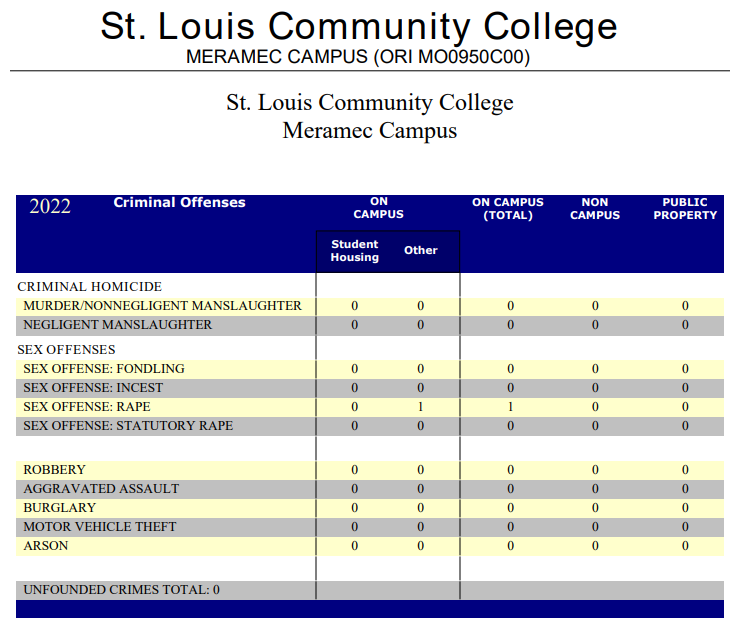Thirteen cars are stolen every day in St. Louis. Are Meramec students at risk?

Shane Rice
– News Editor –
Leaving an iPod in the cup holder, a GPS resting on the dash, or CDs lying in the back seat may not seem like a risk at the time, but Kirkwood Detective David Smith said, “It’s when people start thinking this way, burglars, violent offenders and car thieves strike.”
Auto theft and auto break-ins are nothing new. With technology advancing, it would become harder and harder for thieves to get away.
However, this is not the case. According to the FBI’s Uniform Crime Reports, a car is either broken into or stolen every 26.4 seconds; a number that has decreased over the years.
Although some measures like setting an alarm, locking away personal belongings, and leaving valuables at home can be taken to better secure a person’s belongings in a vehicle, the hard truth is, “If a thief wants in, they’re going to get in,” Smith said. “One of the things thieves look at when deciding on a break-in is location.
Meaning they look for places that you would not normally take a purse or a wallet with you, like a gym or an amusement park.”
STLCC-Meramec Chief of Police Paul Banta said it’s usually people between the ages of 17 to 25 that commit these crimes.
However, according to the Missouri department of crime records, “It’s often younger kids looking for money and cigarettes.”
Most cars get broken into not because the thief wants the car but because they want the expensive item lying on the seat, Banta said.
“Technology has gotten expensive and there are a lot of people that are hurting for money and they will do whatever is the easiest to get it.”
Banta said criminals are usually lazy. The harder it is for them to gain access, the less likely they are to pursue.
“Something people often don’t think about is the advertisement they put on their vehicles,” Banta said. “By blaring their music or putting stickers on their car about what’s under the hood, they are advertising to thieves and in not so many words saying, ‘Look what I got.’”
Although car crimes happen everywhere, it is more common in urban areas, according to a FBI prevention report released in 2009. Smith said Kirkwood gets calls about car break-ins but it’s not as common as other crimes in the area.
Banta, who has been in law enforcement for approximately 30 years and chief of police for campus officers at Meramec for three years, said they have had one call in the three years he’s been there.
“Even that one call was speculative because the lady wasn’t sure if it happened here on campus or somewhere else, but that is the only call I know of in my time here.”
Smith said some of the most common items that thieves look for are money, loose change lying in the center console, CDs, iPods, GPSs, radar detectors, car stereos, speakers and even food.
“Thieves want anything and everything and a common misconception that people have is a locked door is not accessible so they feel safe leaving it out in the open.” Smith said if at all possible, leave these items at home or put them in a backpack that can be easily carried.
When looking at why some areas are targeted more than others when it comes to this sort of vandalism, Banta said thieves don’t want to be seen or noticed. “Our campus is covered with cameras and we have officers patrolling at all times. Even when we’re not seen, we still see everything.”
It’s All About Prevention
STLCC-Meramec Chief of Police Paul Banta said Kirkwood is not a real high-crime area when compared to others, but crime does happen, cars get vandalized, and property does come up missing. However, there are measures people can take to secure not only their belongings but themselves as well.
— Keep all valuables out of sight. Cars can contain costly pieces of removable technology whether it’s an iPod on the seat or an entire stereo system running throughout the car. To prevent theft, it may be necessary to hide valuable items.
— Lock all of the doors and set the alarm. Do this every time, and double-check that it’s done. Even the worst stereo looks a lot better when a thief can just open the door and not draw attention to him/herself by doing so. “If a car doesn’t come with an alarm system then I advise looking into one,” Banta said. “Many thieves will look for the blinking of an alarm light before attempting anything, no matter what is inside.
—Park cars in a well-lit area that is crowded with people.
—Know that the make and model of a car has very little to do with thievery. All the thief cares about is what’s inside.
—Don’t draw attention: Blaring music may be advertising that there is nice equipment in the car and make the car more susceptible to theft.
—If a robbery does happen, don’t freak out: Call the police and parents if needed. “Unfortunately there’s very little a person can do after a theft has happened,” Banta said.
—Don’t leave registration or title in the car. This may make it easier for thieves to sell the stolen car. Instead, maybe store it at home or in an office, or keep it in a purse or wallet.
—Keep a spare key out of reach to a criminal. Spare keys hidden under a car are also accessible to car thefts.
—Park cars with the wheels turned sideways and the emergency brake on. This makes it harder for vehicles to be towed by thieves.











